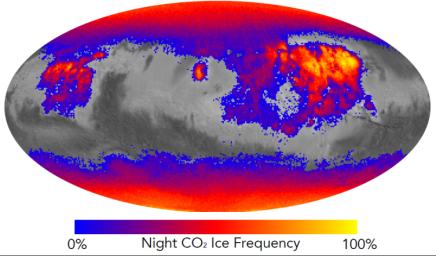
|
Where on Mars Does Carbon Dioxide Frost Form Often?
- Click the image above for a larger view
- Full-Res JPEG (941 x 552) (77.9 kB)
- Full-Res TIFF (941 x 552) (620.9 kB)
Caption:
This map shows the frequency of carbon dioxide frost's presence at sunrise on Mars, as a percentage of days year-round. Carbon dioxide ice more often covers the ground at night in some mid-latitude regions than in polar regions, where it is generally absent for much of summer and fall.
Color coding is based on data from the Mars Climate Sounder instrument on NASA's Mars Reconnaissance Orbiter. A color-key bar below the map shows how colors correspond to frequencies. Yellow indicates high frequencies, identifying areas where carbon dioxide ice is present on the ground at night during most of the year. Blue identifies areas where it is rarely present; red is intermediate. Areas without color coding are regions where carbon dioxide frost is not detected at any time of year.
The areas with highest frequency of overnight carbon dioxide frost correspond to regions with surfaces of loose dust, which do not retain heat well, compared to rockier areas. Those areas also have some of the highest mid-afternoon temperatures on the planet. The dust surface heats up and cools off rapidly.
Background Info:
Six science instruments on the Mars Reconnaissance Orbiter have been examining Mars since 2006. NASA's Jet Propulsion Laboratory, a division of the Caltech in Pasadena, California, manages the mission for NASA's Science Mission Directorate in Washington and built the Mars Climate Sounder. Lockheed Martin Space Systems of Denver built the orbiter and operates it in collaboration with JPL.
Cataloging Keywords:
| Name | Value | Additional Values |
|---|---|---|
| Target | Mars | |
| System | ||
| Target Type | Planet | |
| Mission | Mars Reconnaissance Orbiter (MRO) | |
| Instrument Host | Mars Reconnaissance Orbiter | |
| Host Type | Orbiter | |
| Instrument | MCS | |
| Detector | ||
| Extra Keywords | Color, Dust, Map | |
| Acquisition Date | ||
| Release Date | 2016-07-08 | |
| Date in Caption | ||
| Image Credit | NASA/JPL-Caltech | |
| Source | photojournal.jpl.nasa.gov/catalog/PIA20758 | |
| Identifier | PIA20758 | |
